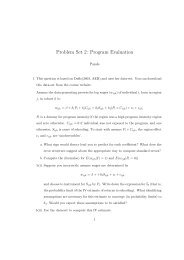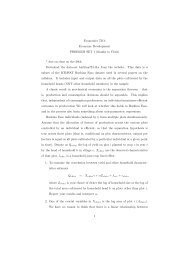The Expected Utility Model: Its Variants, Purposes, Evidence and ...
The Expected Utility Model: Its Variants, Purposes, Evidence and ...
The Expected Utility Model: Its Variants, Purposes, Evidence and ...
You also want an ePaper? Increase the reach of your titles
YUMPU automatically turns print PDFs into web optimized ePapers that Google loves.
Schoemaker: <strong>The</strong> <strong>Expected</strong> <strong>Utility</strong> <strong>Model</strong><br />
553<br />
ments of opportunity <strong>and</strong> out-of-pocket<br />
costs. As Thaler (1980) argues, these biases<br />
afflict organizational as well as individual<br />
decision making.<br />
From a positivistic perspective, the interpretation<br />
of evidence counter to EU<br />
theory is more complicated. A well-known<br />
example of Friedman <strong>and</strong> Savage (1948)<br />
notes that complex equations of rigid. body<br />
mechanics <strong>and</strong> plane geometry may offer<br />
excellent predictiops of the manner in<br />
which expert billiard players take their<br />
shots, even if these players are totally ignorant<br />
of such equations. <strong>The</strong> reason is<br />
that the geometric model captures well<br />
what the players try to do. Since they are<br />
experts, years of training <strong>and</strong> feedback<br />
have led to heuristics that closely approximate<br />
optimal behavior. Four conditions,<br />
however, make this analogy of limited<br />
value to economic behavior. First, most<br />
people are not experts in economic matters<br />
(Thaler, 1980). Second, learning from<br />
feedback is not a simple or automatic activity<br />
in daily decision making. Uncertainty,<br />
environmental instability, improper<br />
assessment frameworks, <strong>and</strong> lack<br />
of insight into one's decision rules are all<br />
serious obstacles to learning from experience<br />
(Einhorn, 1980). Third, the optimality<br />
of economic behavior in real-world settings<br />
is often difficult to assess without<br />
specific knowledge of the person's utility<br />
function, the particular problem perception,<br />
<strong>and</strong> the rationality criteria being pursued<br />
(March, 1978). Finally, even if the<br />
EU model did predict well (while its assumptions<br />
are wrong) the notion that only<br />
prediction matters is epistemologically<br />
quite unappealing (Paul Samuelson, 1963).<br />
For instance, it would be interesting to<br />
know what makes the model so robust under<br />
misspecification (Robyn Dawes, 1979).<br />
A second reaction, from a positivistic<br />
economic perspective, is to note that individual<br />
biases <strong>and</strong> differences may not matter<br />
in aggregate behavior. For example,<br />
Stigler <strong>and</strong> Becker (1977) argued that peo-<br />
ple may usefully be treated as similar in<br />
basic tastes <strong>and</strong> preferences, both across<br />
time <strong>and</strong> persons. Moreover, market<br />
mechanisms may be presumed to correct<br />
misperceptions <strong>and</strong> individual decision biases.<br />
However, not necessarily. Paul<br />
Kleindorfer <strong>and</strong> Kunreuther (1982) examined<br />
analytically the effect of probability<br />
misinformation (by firms <strong>and</strong> consumers)<br />
on insurance markets. Using Rothschild's<br />
<strong>and</strong> Joseph Stiglitz' (1976) solution to the<br />
adverse selection problem (i.e., allowing<br />
insurers to offer varying dollar premiums<br />
as a function of total coverage), they established<br />
various conditions under which the<br />
market fails. Pratt, Wise <strong>and</strong> Zeckhauser's<br />
1979 study on price differences among<br />
highly similar consumer products also<br />
demonstrates a failure of the market to<br />
correct individual biases. Finally, Thomas<br />
C. Schelling (1978) discusses many other<br />
examples of "irrational" macro behavior,<br />
such as drivers incurring a thirty minute<br />
delay to have a one-minute peek at some<br />
highway accident. <strong>The</strong> point to be made<br />
is that the connection between micro <strong>and</strong><br />
macro behavior is too complex to argue<br />
that at higher levels of social aggregation<br />
individual biases generally wash out or<br />
self-correct.<br />
As a third discussion point, let us examine<br />
the view that hypothetical <strong>and</strong> "artificial"<br />
laboratory experiments have limited<br />
implications for economic theory. Sociological<br />
research (H. Schuman <strong>and</strong> M. P.<br />
Johnson, 1976) indeed underscores the<br />
consideration that intentions (i.e., hypothetical<br />
choices) cannot be mechanically<br />
substituted for, or assumed to be generally<br />
highly correlated with, actual behavior. In<br />
the context of gambles, however, several<br />
empirical studies by Nathan Kogan <strong>and</strong><br />
Michael Wallach (1967) <strong>and</strong> Slovic (1969)<br />
on the effect of hypothetical vs. real payoffs<br />
suggest that cognitive processes <strong>and</strong><br />
decisions do not differ considerably between<br />
these two conditions. Indeed, I<br />
know of no evidence that suboptimal labo-




